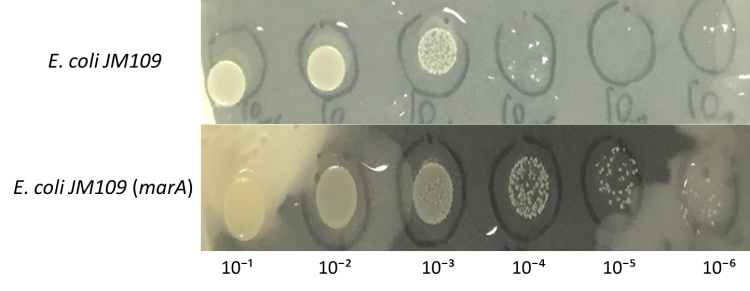BioBrick Parts to achieve each medal requirement
Bronze
We created 3 new BioBricks [1 ](https://2016.igem.org/Team:Nagahama/Our_all_BioBricks) for bronze medal criterion. And have documented and submitted them to igem Registry.
We introduce yajo (http://parts.igem.org/Part:BBa_K1950005) of them. This biobrick is Key BioBrics in “Flavorator” project. Yajo encodes novel 1-deoxyxylulose-5-phosphate synthase. The novel 1-deoxyxylulose-5-phosphate synthase is able to synthesize 1-deoxy-D-xylulose 5-phosphate (DXP) from ribulose 5-phosphate, proving a novel route from a pentose phosphate to DXP Therefor the enzyme can catalyze in the polyisoprenoid biosynthetic pathway.
Silver
We created 3 new BioBrick devices for silver medal criterion.
1.trc promoter + ispC-ribB(G108S) fusion
We want to make Escherichia coli synthesize a lot of farnesol, which is one kind of terpenes. We can achieve this purpose by fusing two genes, ispC and ribB(G108S).(http://parts.igem.org/Part:BBa_K1950010)
We tested whether the fusing gene was made by measuring ispC and ribB(G108S) transcription. The amounts of transcription were quantified by RT-RCR. In the fusion gene, ispC and ribB(G108S) are transferred from a single promoter. If two genes are fused successfully, two genes are expected to be higher in the recombinant than in WT.
2-1:PgpB.dev
2-2:YbjG.dev
To realize "Flovorator" we need to make E. coli produce Farnesol.
We have succeeded in confirming amount of transcription of PgpB.dev and YbjG.dev .
Our new biobrick device “PgpB.dev” and ”YbjG.dev” worked as expected.
Because we validate this fact by RT-PCR analysis experimentally. We have documented and submitted this new Biobrick device (http://parts.igem.org/Part:BBa_K1950007)
(http://parts.igem.org/Part:BBa_K1950008) to iGEM Registry .
We want to make the E. coli produces farnesol which are one of the terpenes.
To produce great quantity of terpenes they need many terpene precursor and Farnesol synthase.
E. coli produces a small amount of the terpene precursor in MEP pathway.
In addition, E. coli has dephosphorylation enzyme of endogenous.
This is likely to synthesize farnesol from Farnesyl diphosphate (FPP), which is a precursor of farnesol.
In MEP pathway, there are four enzymes (ispD, ispF, idi, dxs) which are speed limiting enzyme for terpenes precursors produce in E. coli.
Last year, in order to, create a high-yield strains producing IPP and DMAPP, we exogenously engineered to superimpose these genes into E. coli to create strains overproducing IPP and DMAPP.
This year, in order to generate a large amount of further farnesol, exogenously engineer genes coding for farnesol enzyme synthesis , YbjG and PgpB, as farnesol synthesis in E. coli. These are endogenous dephosphorylation enzyme of E. coli.
Farnesol is generated through FPP hydrolysis by PgpB and YbjG of endogenous phosphatases , which are induced by an increased intracellular FPP level.
To confirm whether the transcription of these genes is going well or not, we confirmed amount of the transcription of these genes by RT-PCR.
Result:(fig◯)
Discussion:
Gold
marA :The activator of AcrAB-TolC multidrug efflux pump exports some terpenes
We improved the characterization of a previously existing BioBrick Part BBa_K1230000 and (http://parts.igem.org/Part:BBa_K1230000) the characterization of a previously existing BioBrick marAgene as BBa_K1653006 . In existing part's information of marA, it gives E. coli resistance against kanamycin and give E-Coli resistance against geraniol as one of the terpene and decrease its intracellular concentration. In this year, we confirmed that overexpressing of marA gives E. coli resistance against farnesol as one of the terpene. This information is very beneficial for other iGEMers to production of toxic organic substances that are produced using bacteria.
We introduce an activator gene of AcrAB-TolC efflux pump (MarA) to release the farnesol from the cells and increase the content in the media that shows increase these flavors in the "Flavolator". In our study, we confirmed that overexpressing of marA gives host E. coli high resistance against farnesol.

E.coli JM109 and E.coli JM109 (marA) were dropped on LBGMg agar plates in serial ten-fold dilutions (10⁻¹~〖10〗^(-6)), overlaid with 30 % (v/v) farnesol hexane solution (farnesol solution) and incubated at 30°C for 24 h. This figure shows that E.coli JM109 (marA) cells that overexpress the marA product better than the control E.coli JM109 wild type cells survived plates overloyed by 30 % farnesol solution.
Farnesol production device(http://parts.igem.org/Part:BBa_K1653025)
To realize "Flovorator" we need to make E. coli produce Farnesol. Surprisingly, last year, we have succeeded in farnesol production by Farnesol production device. Our previous biobrick device "Farnesol production device" worked as expected. Because we validated this fact by GC-MS analysis experimentally. We confirmed expression level of genes used in the 2015 fiscal year project for reference of farnesol production increase. We improved the characterization of a previously existing BioBrick Part BBa_K1653025 In existing part's information of farnesol production device, it gives E. coli farnesol production. In this year,
This information is very beneficial for other iGEMers to farnesol that are produced using bacteria.
結果の図を入れる





